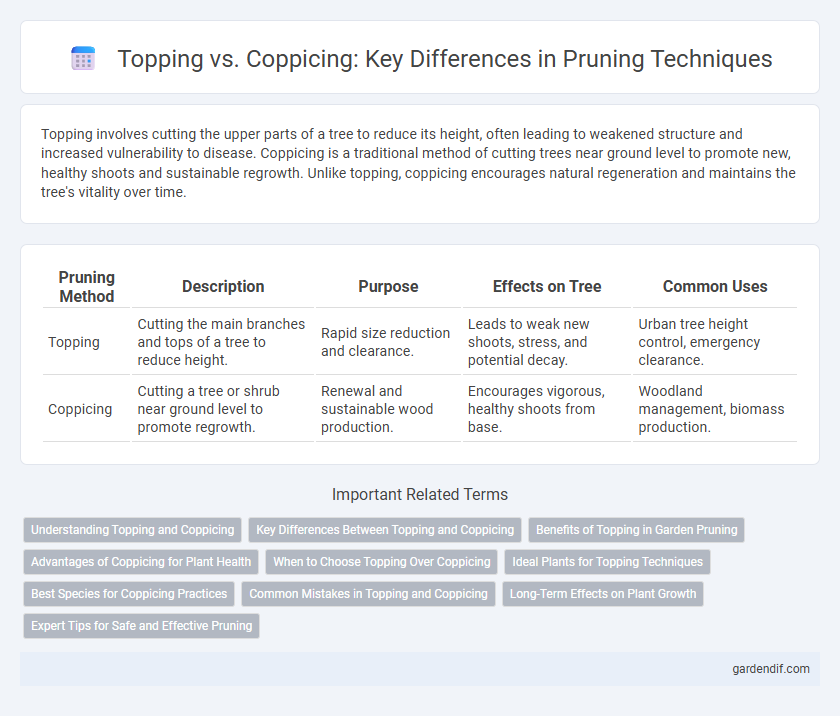
Topping vs coppicing Illustration
Topping involves cutting the upper parts of a tree to reduce its height, often leading to weakened structure and increased vulnerability to disease. Coppicing is a traditional method of cutting trees near ground level to promote new, healthy shoots and sustainable regrowth. Unlike topping, coppicing encourages natural regeneration and maintains the tree's vitality over time.
Table of Comparison
| Pruning Method | Description | Purpose | Effects on Tree | Common Uses |
|---|---|---|---|---|
| Topping | Cutting the main branches and tops of a tree to reduce height. | Rapid size reduction and clearance. | Leads to weak new shoots, stress, and potential decay. | Urban tree height control, emergency clearance. |
| Coppicing | Cutting a tree or shrub near ground level to promote regrowth. | Renewal and sustainable wood production. | Encourages vigorous, healthy shoots from base. | Woodland management, biomass production. |
Understanding Topping and Coppicing
Topping involves cutting the upper parts of a tree to reduce its height, which can cause stress and increase vulnerability to disease and decay. Coppicing is a traditional woodland management technique where a tree is cut near ground level to encourage new shoots, promoting sustainable regrowth and maintaining tree health. Understanding the differences between topping and coppicing helps in selecting the appropriate pruning method for tree longevity and ecosystem balance.
Key Differences Between Topping and Coppicing
Topping involves cutting the upper portion of a tree's main stem or branches, often resulting in weakened structural integrity and increased vulnerability to disease. Coppicing is the practice of cutting a tree or shrub down to its base to encourage new, healthy shoots to grow from the stump, promoting sustainable regrowth and maintaining plant health. Key differences include their impact on tree health, with coppicing supporting regeneration and topping often causing long-term damage.
Benefits of Topping in Garden Pruning
Topping in garden pruning effectively controls tree height and encourages the growth of strong lateral branches, improving overall plant structure and sunlight penetration. This method reduces shading on lower plants, enhancing air circulation and promoting healthier garden ecosystems. Topping also helps in minimizing storm damage risks by managing tree size and branch distribution.
Advantages of Coppicing for Plant Health
Coppicing promotes healthier plant growth by encouraging vigorous new shoots from the base, leading to a more sustainable and resilient structure compared to topping. This method reduces the risk of disease and decay often associated with exposed, stubby branches left after topping. Coppicing enhances nutrient allocation within the plant, supporting long-term vitality and improved overall health.
When to Choose Topping Over Coppicing
Topping is chosen over coppicing when the goal is to reduce tree height quickly for safety or clearance without promoting regrowth from the base, often in urban or utility line settings. This method is suitable for mature trees where immediate size control is required, but it may cause stress or structural weaknesses in the tree. Coppicing is preferred when sustainable regrowth and long-term wood production are desired, as it encourages new shoots from the stump.
Ideal Plants for Topping Techniques
Topping is ideal for large, hardy trees such as oaks, maples, and pines that can tolerate severe crown reduction without significant stress. These species respond well by producing vigorous lateral shoots and maintaining structural integrity after pruning. Unlike coppicing, which suits species with strong basal sprouting like willow or hazel, topping is preferred for trees requiring controlled size reduction and shaping.
Best Species for Coppicing Practices
Best species for coppicing include hardwoods such as willow (Salix spp.), hazel (Corylus avellana), and ash (Fraxinus excelsior), known for their vigorous regrowth after cutting. These species respond well to coppicing by producing multiple shoots from the base, making them ideal for sustainable wood production and habitat management. Fast-growing species like poplar (Populus spp.) also perform well, providing renewable biomass with repeated harvest cycles.
Common Mistakes in Topping and Coppicing
Topping often results in weak, poorly attached branches that are prone to disease and decay, compromising tree health and safety. Coppicing mistakes include cutting too high or too low, which can stunt regrowth or damage the root system, leading to poor recovery. Both practices require precise cutting techniques to avoid common errors that hinder plant vigor and structure.
Long-Term Effects on Plant Growth
Topping often leads to weak branch structure and increased susceptibility to pests and diseases, negatively affecting long-term plant health. Coppicing promotes vigorous regrowth by cutting the plant close to the ground, encouraging a sustainable cycle of renewal and strong root systems. Over time, coppiced plants typically maintain better vitality and structural integrity compared to those subjected to topping.
Expert Tips for Safe and Effective Pruning
Topping is an aggressive pruning method that removes the top of a tree, often causing stress and weak regrowth, while coppicing involves cutting a tree down to its base to stimulate new, healthy shoots. Experts recommend avoiding topping to preserve tree structure and health, emphasizing coppicing or selective pruning to maintain vigor and reduce disease risk. Safe and effective pruning practices include using sharp tools, making clean cuts at the branch collar, and pruning during dormant seasons for optimal recovery.
Topping vs coppicing Infographic

 gardendif.com
gardendif.com